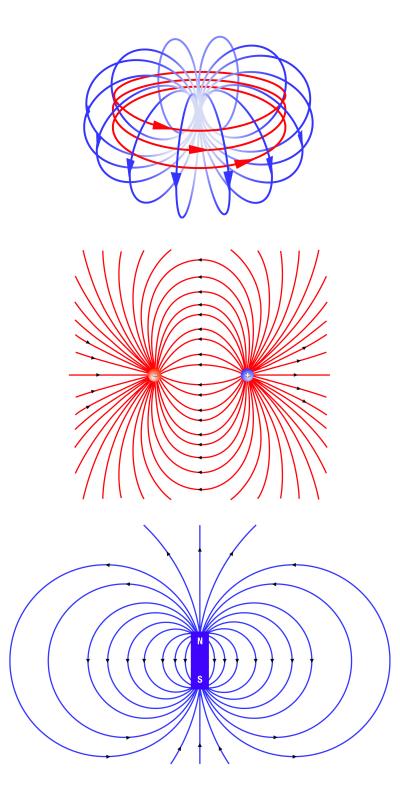
Artist’s impression of the Milky Way galaxy. The blue halo of material surrounding the galaxy indicates the expected distribution of dark matter. (ESO/Calçada)
Scientists at Vanderbilt University believe dark matter, an invisible substance that makes up almost 85 percent of our universe, might be made out of particles that have an unusual, donut-shaped electromagnetic field called an anapole.
A number of theories concerning dark matter have been developed over the years, but the Vanderbilt University scientists have come up with a relatively simple theory to explain what has so far been unexplainable.

Top image: Comparison of an anapole field in red with common electric and magnetic dipole field, blue. Middle & Bottom: Anapole field – red and Dipole field – blue (Michael Smeltzer, Vanderbilt University)
In a paper entitled Anapole Dark Matter, they suggest dark matter particles are surrounded by a rare form of electromagnetism.
“There are a great many different theories about the nature of dark matter. What I like about this theory is its simplicity, uniqueness, and the fact that it can be tested,” said Professor Robert Scherrer, a theoretical physicist at Vanderbilt University who performed a detailed analysis along with post-doctoral fellow Chiu Man Ho.
The two physicists believe dark matter might be made out of a type of elementary electrically neutral particle called the Majorana fermion (or Majorana Particle). The existence of this particle was predicted by Italian physicist Ettore Majorana in 1937, but has so far escaped detection.
Fermions – predicted by Paul Dirac in 1928 and named after the renowned physicist Enrico Fermi – are thought to be basic particles that scientists consider to be the building blocks of matter. Some scientists think the Marjorana fermion may be a neutrino, but they haven’t been able determine the basic nature of this unique and mysterious particle.
While a number of physicists have also previously suggested that dark matter is composed of Majorana particles, Scherrer and Ho performed detailed calculations they believe prove the particles are uniquely suitable to have a rare, donut-shaped type of electromagnetic field called an anapole.

Ettore Majorana – Circa 1906. The Marjoran fermion or particle was predicted by him in 1937, but so far has escaped detection. (Wikimedia Commons)
The Majorana fermions are difficult to detect, according to Scherrer and Ho, because this anapole field gives the particles certain properties that make them quite different from others that have more common fields comprised of two poles – north and south, positive and negative.
“Most models for dark matter assume that it interacts through exotic forces that we do not encounter in everyday life,” said Scherrer. “Anapole dark matter makes use of ordinary electromagnetism that you learned about in school: the same force that makes magnets stick to your refrigerator or makes a balloon rubbed on your hair stick to the ceiling. Further, the model makes very specific predictions about the rate at which it should show up in the vast dark matter detectors that are buried underground all over the world. These predictions show that soon the existence of anapole dark matter should either be discovered or ruled out by these experiments.”
Scientists developed the concept of dark matter in the 1930s, while trying to explain discrepancies in the rotational rate of galactic clusters. Since then, astronomers have also found similar inconsistencies in the rate at which stars rotate around individual galaxies. Assuming they contain a large amount of invisible dark matter is the most straightforward way to explain these discrepancies.